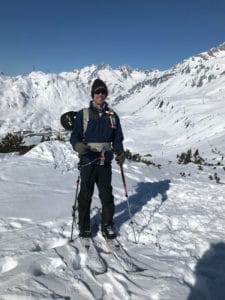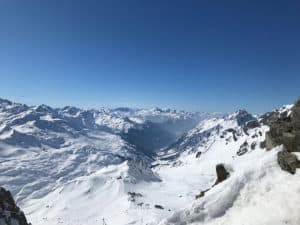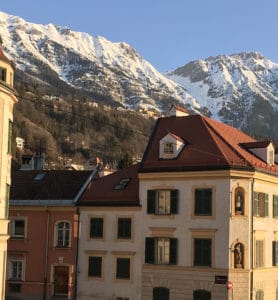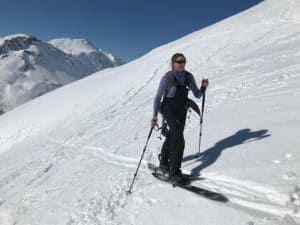By Eesha Williams
How did I, a Vermont veggie farmer, end up on the slopes of the Austrian Alps? If I were rich and Austria got a giant snowstorm, perhaps I’d want to go ride powder. But I’m not rich. Instead I’m taking Austria up on its offer for citizenship and visiting the place where my ancestors grew up. My wife, Liz, and I flew into Innsbruck, Austria. Innsbruck is a great town, with excellent skiing, with ski lifts literally in the downtown, and it’s an hour by train from St. Anton — a worldclass ski resort.

Eesha Williams skis on a sunny day in the Austrian Alps.
My maternal grandmother was born in Innsbruck and grew up downhill skiing there — before ski lifts were common — until she was forced out by the Nazis. She was Jewish.
In 2019, Austria passed a law that gave citizenship to people like me. Liz and I decided to snowboard in Innsbruck and St. Anton on our way to WWOOF in Japan (Liz was born in Japan and speaks Japanese) on a sabbatical year to celebrate 20 years at our southern Vermont veggie farm (located in Dummerston).

Vermont veggie farmer Eesha Williams takes a sabbatical and travels to the Austrian Alps in a quest to see and understand where his ancestors grew up.
We rented an apartment in downtown Innsbruck for $80 a night. It was on the bank of the river that runs through the city of 130,000 people. A croissant bakery was next door — they were the best croissants we’d ever had. Our apartment was a 5 minute walk from the Nordkette ski lift. This little ski area has amazing terrain. We got sunshine and slush. No lift lines. Lift tickets are $36. We rode the gondola to the summit and snowboarded a huge area by ourselves. It was as steep as the steepest runs at Crested Butte, which is known for its steeps.
The next day we visited Thaur, a small town just outside Innsbruck known for its vegetable farms. We are veggie farmers in Vermont and wanted to see how it’s done in Austria.
The day after that we took the train to St. Anton and stayed at the hotel Kösslerhof. It seems that many hotels in Austria come with fancy dinners and breakfasts included. The hotel is deluxe but not cheap. Innsbruck has much more affordable hotels but train tickets would quickly add up if you were commuting daily. The good news is lift tickets are a bargain at St. Anton compared to comparable resorts in the U.S. Just $67 gets you a resort at least as big as Vail (which charges $239 for a day lift ticket) with the fanciest possible gondolas and chair lifts.
Liz and I wanted to splitboard St. Anton, to have a similar experience to what my grandma would have had as a girl in the 1930s. Our avalanche safety guide, Tom Kleinlercher of St. Anton Classic Mountain Guides, was excellent.

A view from Eesha Williams’ apartment in Innsbruck, where he stayed during a sabbatical.
The next day we stayed on groomed trails. Lift lines were minimal. Conditions were slush and sunshine, again, no clouds and no wind. Innsbruck and St. Anton are both cheap places to rent top-of-the-line snowboards. Splitboard rentals are more expensive and come with avalanche safety gear.
In Vermont, before we left we practiced splitboarding at Bolton Valley, one of the few places in the Northeast where you can rent splitboards. (You can also rent them in Killington.)
According to the top Google results for “average annual snowfall for x resort,” St. Anton gets 23 feet, Palisades Tahoe gets 33 feet, Copper in Colorado gets 25 feet, and Killington, Vermont gets 21 feet.
Austria is not perfect. There is little racial diversity (less than half of 1% of Austrians are black. That compares to 3% in England and Wales, 13% in the USA, and 56% in Brazil) and Austria is just 700 miles from Africa. That’s closer than Los Angeles is to Denver.

Liz Wood split-boards on a warm day of exploring in the Austrian Alps.
Last year, 1,600 or so people died while trying to immigrate from Africa to Europe by crossing the Mediterranean sea. As of 2019 the average annual household income in Austria was the equivalent of $41,000 (U.S. dollars). In Uganda it was the equivalent of $700 (U.S. dollars). In the U.S. it was $55,000.
But the USA is hardly a model of racial equality — just look at our “justice” system, from George Floyd to the wildly disproportionate percentage of African Americans in prison.
Actions speak louder than words. In 2019, the government of Austria bowed to decades of pressure from Jewish activists and passed the law that gave me citizenship. Maybe one day Austria will allow more Africans to immigrate legally. And they’re doing better than the U.S. environmentally. In 2018, the average Austrian created 7 tons of carbon dioxide emissions. The average American created 15 tons. (The average Ugandan, 0.1 tons).
So if we want to continue to have powder days on the slopes we Americans need to learn from Austria and Uganda.
Eesha Williams is an award-winning journalist who helps run an organic vegetable farm in southern Vermont with his wife. He’s a supporter of Jewish Voice for Peace, which works for a free Palestine, and the Ella Baker Center, which has had inspiring victories in its fight to end mass incarceration in the U.S.




